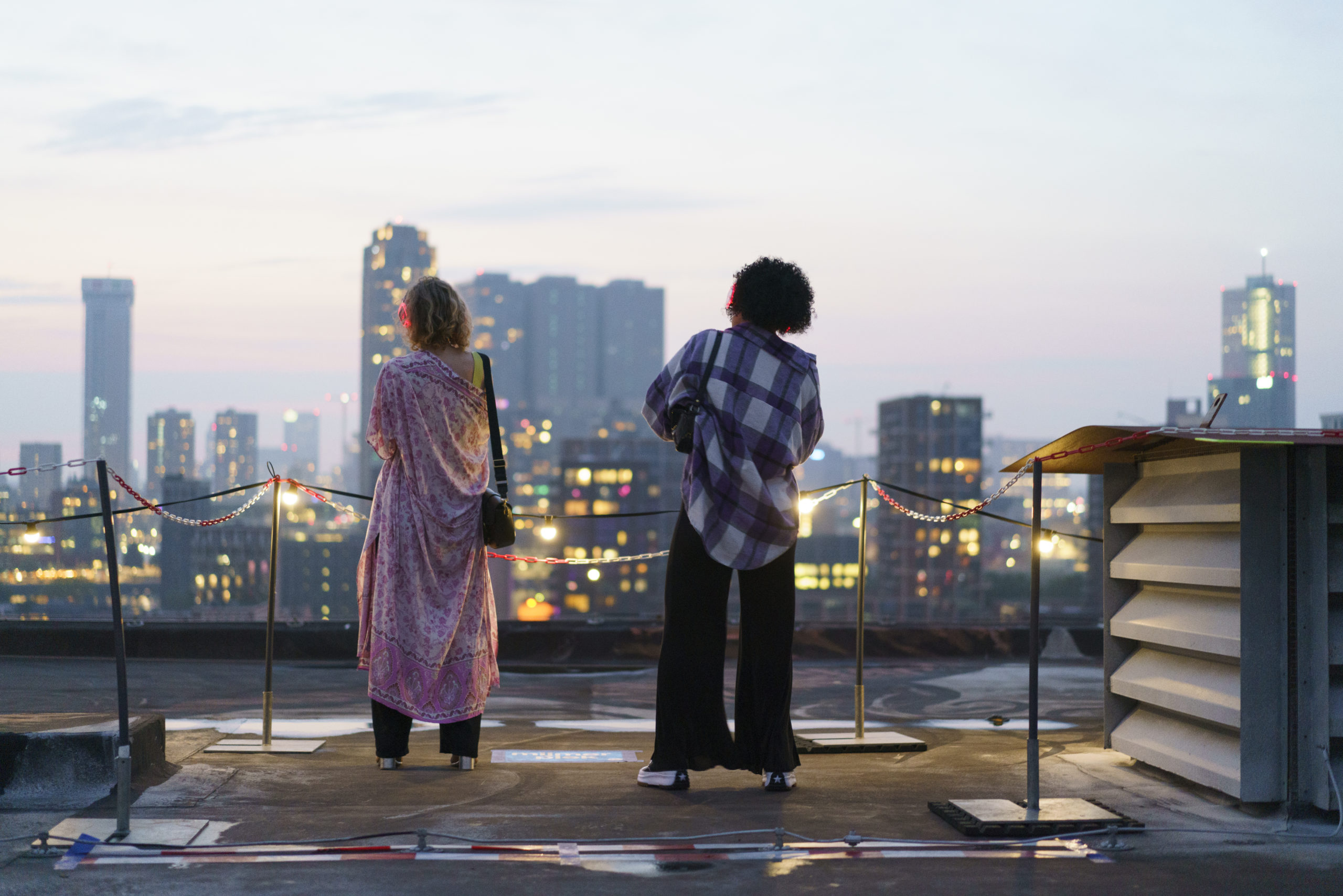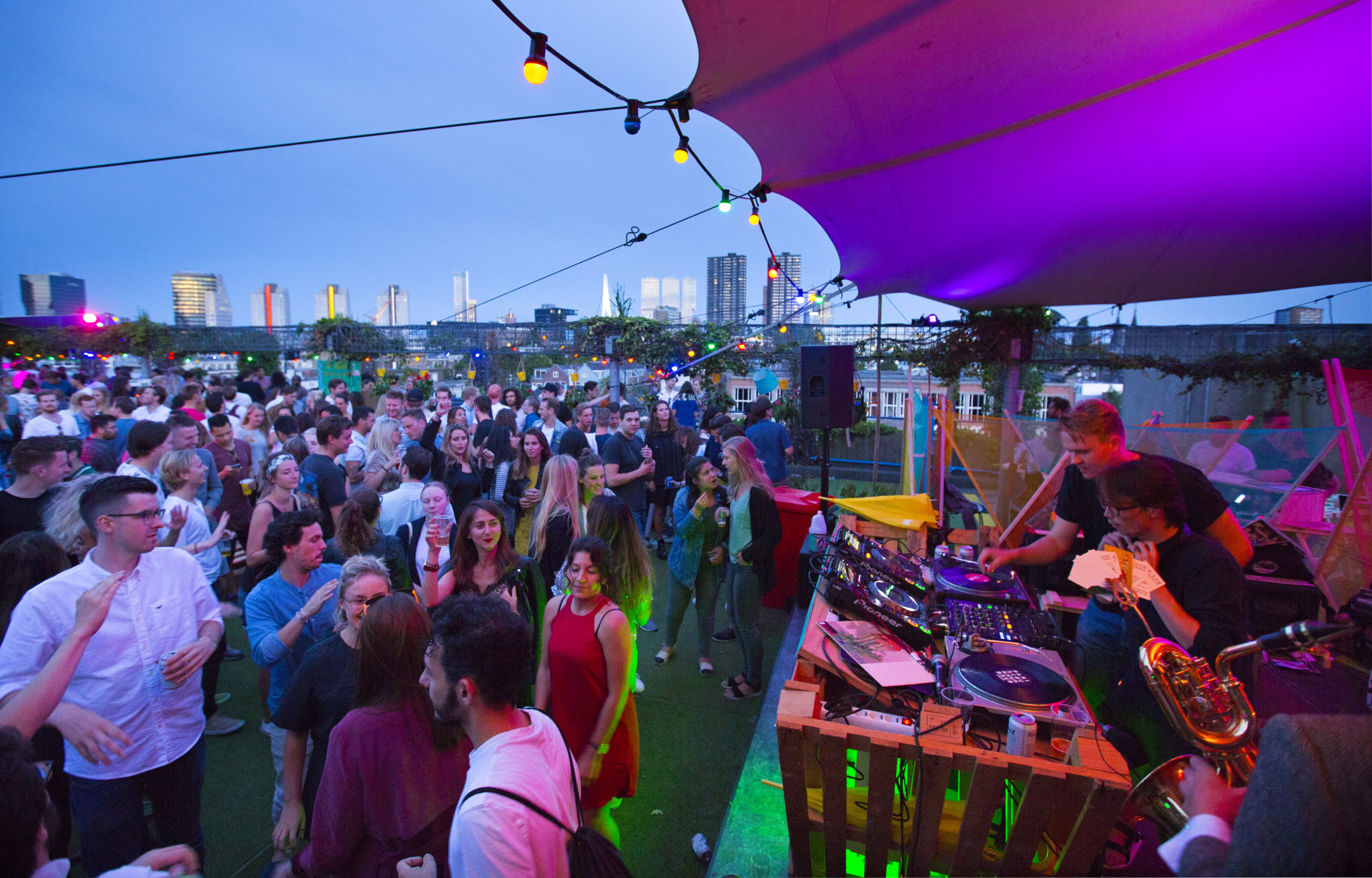
‘Space is more than plentiful’
Showcase
High lines sweeping across the sky from one roof to another. Zip lines and pedestrian bridges hovering over the Coolsingel. Some people might be tempted to tag the programme of the Rotterdamse Dakendagen as ‘unconventional’ or ‘bizarre’ at times, but festival director Léon van Geest finds that hard to understand: ‘I think what we are doing is perfectly logical’.
As soon as Léon van Geest opens the door that leads to the roof of the De Bijenkorf building and guides a group of people out onto the roof, the exclamations of enthusiasm are unmistakeable. And the view is spectacular; in the distance we can see the Erasmus Bridge and the Markthal, as well as the summits of a number of residential towers. And far below we can see the Koopgoot and Coolsingel, teeming with shoppers. This is an experience that leaves nobody untouched. Says Van Geest, who organised his first edition of the Rotterdamse Dakendagen in 2015: ‘This is what we have been doing for eight years now; showing people how much unused space there still is in our city. Making them enthusiastic about the use of roofs and showing them the enormous possibilities, hoping that perhaps a developer will come up with an original idea’.
Teamwork
Van Geest, together with co-director Nikki Kamps and a team of ten passionate co-workers, is working his way towards a new edition of the Rotterdamse Dakendagen. People will be able to take to the roofs again from 3 to 5 June 2022, when fifty roofs – with special events being organised on many of them – can be visited in a single weekend.
In the 2017 festival, the very roof on which we are now standing, that of the De Bijenkorf department store, was the venue for a sculpture exhibition that attracted 10,000 visitors. A year later, it was converted into a field of lavender, which attracted another 8,000. Van Geest: ‘We were also sending a message to De Bijenkorf; your roof is of value and people like to visit it. We try to stimulate people to make the most of their roofs. After all, we are currently just standing on pebbles, but just imagine the potential of this site’.
'We are the only city with a multifunctional roof policy'
Connecting roofs
Léon van Geest wants to make it clear by means of the Rotterdamse Dakendagen how roofs can contribute to a healthy, dynamic, inclusive, attractive and future-proof city: ‘Battles are fought, as it were, over space at ground level, but that same space is just there for the taking on the roofs’. He makes use of temporariness to address that theme. Van Geest says: ‘If you wanted to ensure green sustainability of the roof of De Bijenkorf, the department store would almost certainly say: “Do you have half a million to spare? Because this will obviously require investment”. The municipality would also sit up and take notice, being concerned about zoning plans etc. Then again, if we make it clear that we would just like to use the roof for a month or so as the venue for a thrilling event, there are no objections. That temporariness gives us the opportunity to display inspiring examples and enthuse people’.
In past years, the Rotterdamse Dakendagen have organised tours, concerts and performances on the rooftops. The festival has shown how roofs can be deployed for sports and games and for art and culture, as well as for get-togethers. It also makes clear the ways in which roofs can be used to generate energy, harvest water and reduce heat stress. Says Van Geest: ‘The number of arguments to use the potential of our roof landscape continues to grow’.
Roof landscape you will note. Indeed, Van Geest doesn’t want us to look upon the roofs of Rotterdam as isolated islands, but rather as a true landscape, the way it used to be portrayed in futuristic cartoons like The Jetsons. He says: ‘We want to deploy the Rotterdamse Dakendagen to connect roofs, not just with one another, but also with the ground, so that they will truly form a part of the city that can be used by everybody’.
So this year the festival will be organising the Rotterdam Rooftop Walk, an aerial walkway connecting the roofs of the De Bijenkorf department store and the WTC. The festival has collaborated with the Rotterdam architecture bureau MVRDV to work out the design, and Dutch Steigers have been engaged for the construction. Says Van Geest (pointing to the edge of the De Bijenkorf roof): ‘You will be able to cross the Coolsingel from this point, and experience for yourself what it is like to walk from one roof to another. Thrilling? Not particularly, is it?’
Stretching a high line
The 2017 edition of the festival was the first time that people were able to move from one roof to another. In both 2017 and 2018, Rotterdamse Dakendagen had lines suspended between prominent buildings in Rotterdam, and in 2019, visitors could be fitted with a harness and sweep from one building to another using a zip-line. Van Geest says (putting on a funny voice): ‘People are apt to say: “Oh, how spectacular, really bizarre!” But we are quite serious; we want to take people from one roof to another. This year we invite everyone to come and enjoy the Rotterdam Rooftop Walk, so that together we can discover the huge potential of the 18.5 square kilometres of flat roofs that Rotterdam is home to. That’s 18.5 times the area of the Kralingse Plas!’
The Rotterdam Rooftop Walk will be a walk at a height and an exhibition rolled into one because, while strolling high above the Coolsingel and the shoppers and queuing cars, you will pass presentations of outstanding roof projects like the Schieblock with its DakAkker, the Depot of the Boijmans Van Beuningen Museum and De Groene Kaap. These were all designed by Rotterdam bureaus, but the Rotterdamse Dakendagen is not just a Rotterdam party, as Van Geest explains: ‘Certainly not; we are intent on expanding the movement substantially, and so we are exchanging expertise, ideas and inspiration with other cities on a large scale. So far we have formed an alliance with eight European cities: Barcelona, Nicosia, Faro, Belfast, Amsterdam, Antwerp, Chemnitz and Göteborg. The fact that these cities are so different makes it all the more interesting, because we all have our own approach. Obviously, we follow the developments in other cities with great interest. Paris, for one, with their urban farms on roofs, and New York, where they have shown outstanding innovation in terms of roofs.
Rotterdam has made great progress in the past few years when it comes to attention for roofs. We are the only city I know that has a multifunctional roof policy, with civil servants involved on a full-time basis’.
'We make use of the temporariness to demonstrate the potential of roofs'
Tickling the imagination
An architecture festival in sheep’s clothing… That is how Van Geest sometimes jokingly refers to his Dakendagen: ‘It’s about the city and its architecture, but from a more interesting perspective, including tours and special experiences on roofs’. Out of the blue, the bells of the WTC start ringing and we can no longer hear one another. Van Geest, trying to shout above the noise: ‘THIS IS A WORK OF ART. IT LASTS FIVE MINUTES!’ We use the time to contemplate the pebbles under our feet and imagine alternative possibilities, high up here on the roof of De Bijenkorf: an opulent roof garden, a terrace, solar panels, or perhaps a sports field? When the sound of the bells has subsided, Van Geest says: ‘Anything is possible, and I am convinced that this roof will be accessible and/or green within ten years. Processes always play out slowly in architecture, and we simply need to exercise patience. People always find it quite special to access a roof, and bizarre to walk to the other side using an aerial walkway, and as long as they do, we still have plenty of work to do’.









